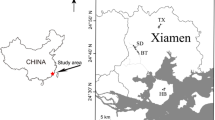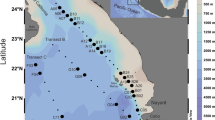Abstract
Phytoplankton is a key biological quality element for the establishment of the Water Framework Directive (WFD) ecological status in reservoirs and lakes. In freshwaters, inverted microscope examination is the traditional standard method for estimating phytoplankton and assessing taxonomic composition. Based on the enumeration of algal units and measurements for biovolume calculation, this technique is cumbersome and time-consuming. In large monitoring programmes, such as the application of the WFD in lakes and reservoirs, chemotaxonomy (HPLC pigment analysis and CHEMTAX treatment) is ideally suited as an alternative method because it allows the rapid processing of large numbers of samples from numerous locations and depths, thereby providing ideal temporal and spatial resolution. The low taxonomical detail obtained by HPLC and CHEMTAX (phytoplankton classes or phyla) can easily be overcome by a rapid inverted microscope screening with identification of the dominant species. Combining HPLC and microscopy provides a useful method for monitoring phytoplankton assemblages, which can be used to implement the WFD with respect to phytoplankton. Here, we present the application of a method combining marker pigments and microscopy to phytoplankton samples from 12 Belgian reservoirs. This method substantially reduced the workload and enabled us to assess the status of the phytoplankton assemblage in these lakes. The method complies with the WFD, as it takes into account taxonomic composition, assesses abundance and biomass of the phytoplankton taxa, and easily detects blooms. Additionally, a set of templates of probability of occurrence of phytoplankton functional groups at the maximal ecological potential for reservoirs from the Central/Baltic region is presented, based on reference conditions defined for natural lakes from other regions.










Similar content being viewed by others
References
Borja A, Franco J, Valencia V, Bald J, Muxika I, Belzunce MJ, Solaun O (2004) Implementation of the European water framework directive from the Basque country (northern Spain): a methodological approach. Mar Pollut Bull 48:209–218
Buchaca T, Felip M, Catalan J (2005) A comparison of HPLC pigment analyses and biovolume estimates of phytoplankton groups in an oligotrophic lake. J Plankton Res 27:91–101
Carvalho L, Maberly S, May L, Reynolds C, Hughes M, Brazier R, Heathwaite L, Liu S, Hilton J, Hornby D, Bennion H, Elliott A, Willby N, Dils R, Phillips G, Pope L, Fozzard, I (2005) Risk assessment methodology for determining nutrient impacts in surface freshwater bodies (Science Report SC020029/SR), Environment Agency, Bristol, (available at http://publications.environment-agency.gov.uk/pdf/SCHO0605BJAW-e-e.pdf )
Descy JP, Higgins HW, Mackey DJ, Hurley JP, Frost TM (2000) Pigment ratios and phytoplankton assessment in northern Wisconsin lakes. J Phycol 36:274–286
Descy J-P, Hardy M-A, Sténuite S, Pirlot S, Leporcq B, Kimirei I, Sekadende B, Mwaitega S, Sinyenza D (2005) Phytoplankton pigments and community composition in Lake Tanganyika. Freshwater Biol 50:668–684
Ediger D, Soydemir N, Kideys AE (2006) Estimation of phytoplankton biomass using HPLC pigment analysis in the southwestern Black Sea. Deep Sea Res 53:1911–1922
European Union (2000) Directive 2000/60/EC of the European Parliament and of the Council establishing a framework for the community action in the field of water policy. Journal of the European Communities 22/12/2000 L327/1
Fietz, S, Nicklisch A (2004) An HPLC analysis of the summer phytoplankton assemblage in Lake Baikal. Freshwater Biol 49:332–345
Fietz S, Kobanova G, Izmest’eva L, Nicklisch A (2005) Regional, vertical and seasonal distribution of phytoplankton and photosynthetic pigments in Lake Baikal. J Plankton Res 27:793–810
Garibotti IA, Vernet M, Kozlowski WA, Ferrario ME (2003) Composition and biomass of phytoplankton assemblages in coastal Antarctic waters: a comparison of chemotaxonomic and microscopic analyses. Mar Ecol Prog Ser 247:27–42
Havskum H, Schlüter L, Scharek R, Berdalet E, Jacquet S (2004) Routine quantification of phytoplankton groups—microscopy or pigment analyses? Mar Ecol Prog Ser 273:31–42
Henriksen P, Riemann B, Kaas H, Sorensen HM, Sorensen HL (2002) Effects of nutrient-limitation and irradiance on marine phytoplankton pigments. J Plankton Res 24:835–858
Hurley JP, Watras CJ (1991) Identification of bacteriochlorophylls in lakes via reverse-phase HPLC. Limnol Oceanogr 36:307–315
Jeffrey SW, Mantoura RFC, Wright SW (eds) (1997) Phytoplankton pigments in oceanography. UNESCO, Paris
Latasa M (2007) Improving estimations of phytoplankton class abundances using CHEMTAX. Mar Ecol Prog Ser 329:13–21
Lepisto L, Holopainen LL, Vuoristo H (2004) Type-specific and indicator taxa of phytoplankton as a quality criterion for assessing the ecological status of Finnish boreal lakes. Limnologica 34:236–248
Lepisto L, Kauppila P, Rapala J, Pekkarinen M, Sammalkorpi I, Villa L (2006) Estimation of reference conditions for phytoplankton in a naturally eutrophic shallow lake. Hydrobiologia 568:55–66
Lewitus AJ, White DL, Tymowski RG, Geesey ME, Hymel SN, Noble PA (2005) Adapting the CHEMTAX method for assessing phytoplankton taxonomic composition in southeastern US estuaries. Estuaries 28:160–172
Mackey MD, Mackey DJ, Higgins HW, Wright SW (1996) CHEMTAX—a program for estimating class abundances from chemical markers: application to HPLC measurements of phytoplankton. Mar Ecol-Prog Ser 144:265–283
Moss B, Stephen D, Alvarez C et al (2003) The determination of ecological status in shallow lakes—a tested system (ECOFRAME) for implementation of the European Water Framework Directive. Aquat Conserv 13:507–549
Muylaert K, Gonzales R, Franck M, Lionard M, Van Der Zee C, Cattrijsse A, Sabbe K, Chou L, Vyverman W (2006) Spatial variation in phytoplankton dynamics in the Belgian coastal zone of the North Sea studied by microscopy, HPLC-CHEMTAX and underway fluorescence recordings. J Sea Res 55:253–265
OECD (1982) Eutrophication of waters. Monitoring, assessment and control. OECD, Paris
Padisák J, Borics G, Grigorszky I, Soroczki-Pinter E (2006) Use of phytoplankton assemblages for monitoring ecological status of lakes within the Water Framework Directive: the assemblage index. Hydrobiologia 553:1–14
Paerl HW, Valdes LM, Pinckney JL, Piehler MF, Dyble J, Moisander, PH (2003) Phytoplankton photopigments as indicators of estuarine and coastal eutrophication. Bioscience 53:953–964
Pedrós-Alió C (2006) Marine microbial diversity: can it be determined? Trends Microbiol 14:257–263
Reynolds CS (2005) Annex 4: Expert judgement of phytoplankton composition—functional groups. In: Solheim AL (ed) Reference Conditions of European Lakes—Indicators and methods for the Water Framework Directive Assessment of Reference conditions, Draft Version 5, 30 December 2005. Rebecca Project, pp 90–104
Reynolds C, Huszar V, Kruk C, Naselli-Flores L, Melo S (2002) Towards a functional classification of the freshwater phytoplankton. J Plankton Res 24:417–428
Rodriguez F, Varela M, Zapata M (2002) Phytoplankton assemblages in the Gerlache and Bransfield Straits (Antarctic Peninsula) determined by light microscopy and CHEMTAX analysis of HPLC pigment data. Deep Sea Res 49:723–747
Roy S, Chanut JP, Gosselin M, Simengando T (1996) Characterization of phytoplankton communities in the lower St Lawrence estuary using HPLC-detected pigments and cell microscopy. Mar Ecol Prog Ser 142:55–73
Salmaso N, Morabito G, Buzzi F, Garibaldi L, Simona M, Mosello R (2006) Phytoplankton as an indicator of the water quality of the deep lakes south of the Alps. Hydrobiologia 563:167–187
Sarmento H, Isumbisho M, Descy JP (2006) Phytoplankton ecology of Lake Kivu (eastern Africa). J Plankton Res 28:815–829
Schlüter L, Mohlenberg F, Havskum H, Larsen S (2000) The use of phytoplankton pigments for identifying and quantifying phytoplankton groups in coastal areas: testing the influence of light and nutrients on pigment/chlorophyll a ratios. Mar Ecol Prog Ser 192:49–63
Schlüter L, Lauridsen TL, Krogh G, Jorgensen T (2006) Identification and quantification of phytoplankton groups in lakes using new pigment ratios—a comparison between pigment analysis by HPLC and microscopy. Freshwater Biol 51:1474–1485
Schmid H, Bauer F, Stich HB (1998) Determination of algal biomass with HPLC pigment analysis from lakes of different trophic state in comparison to microscopically measured biomass. J Plankton Res 20:1651–1661
Solheim AL (2005) Reference conditions of European lakes—indicators and methods for the water framework directive assessment of reference conditions. Draft Version 5, 30 December 2005, Rebecca Project
Sondergaard M, Jeppesen E, Jensen JP, Amsinck SL (2005) Water framework directive: Ecological classification of Danish lakes. J Appl Ecol 42:616–629
Utermöhl H (1958) Zur Vervollkommnung der quantitativen Phytoplankton Methodik. Mitt Int Ver Limnol 9:1–38
Wright SW, Jeffrey SW, Mantoura RFC, Llewellyn CA, Bjornland T, Repeta D, Welschmeyer N (1991) Improved HPLC method for the analysis of chlorophylls and carotenoids from marine-phytoplankton. Mar Ecol Prog Ser 77:183–196
Wright S, Jeffrey S (2006) Pigment markers for phytoplankton production. In: Volkman J (ed) Marine organic matter: biomarkers, isotopes and DNA. Springer, Berlin, pp 71–104
Yacobi YZ, Pollingher U, Gonen Y, Gerhardt V, Sukenik A (1996) HPLC analysis of phytoplankton pigments from Lake Kinneret with special reference to the bloom-forming dinoflagellate Peridinium gatunense (Dinophyceae) and chlorophyll degradation products. J Plankton Res 18:1781–1796
Acknowledgements
This study was funded by the Walloon Region water authorities (Région Wallonne—Direction générale des Ressources naturelles et de l’Environnement), in collaboration with the Walloon Scientific Institute of Public Services (ISSeP—Institut Scientifique de Service Public). We are thankful to Pierre Gérard and Pierre-Nicolas Libert (Région Wallonne—Direction générale des Ressources naturelles et de l’Environnement) for their support to this study, and to Bruno Leporcq for field assistance and HPLC analysis. We are also thankful to an anonymous referee who helped improve the manuscript.
Author information
Authors and Affiliations
Corresponding author
Rights and permissions
About this article
Cite this article
Sarmento, H., Descy, JP. Use of marker pigments and functional groups for assessing the status of phytoplankton assemblages in lakes. J Appl Phycol 20, 1001–1011 (2008). https://doi.org/10.1007/s10811-007-9294-0
Received:
Revised:
Accepted:
Published:
Issue Date:
DOI: https://doi.org/10.1007/s10811-007-9294-0




